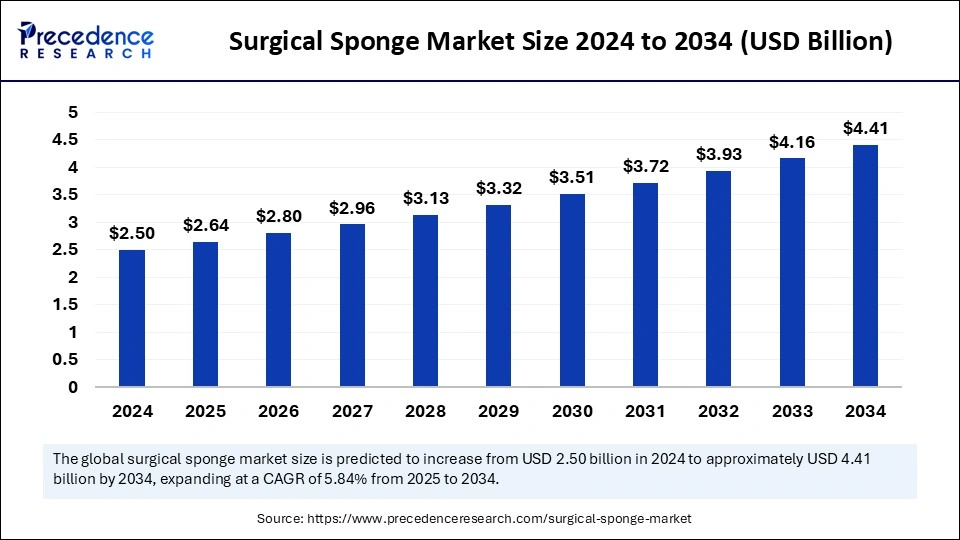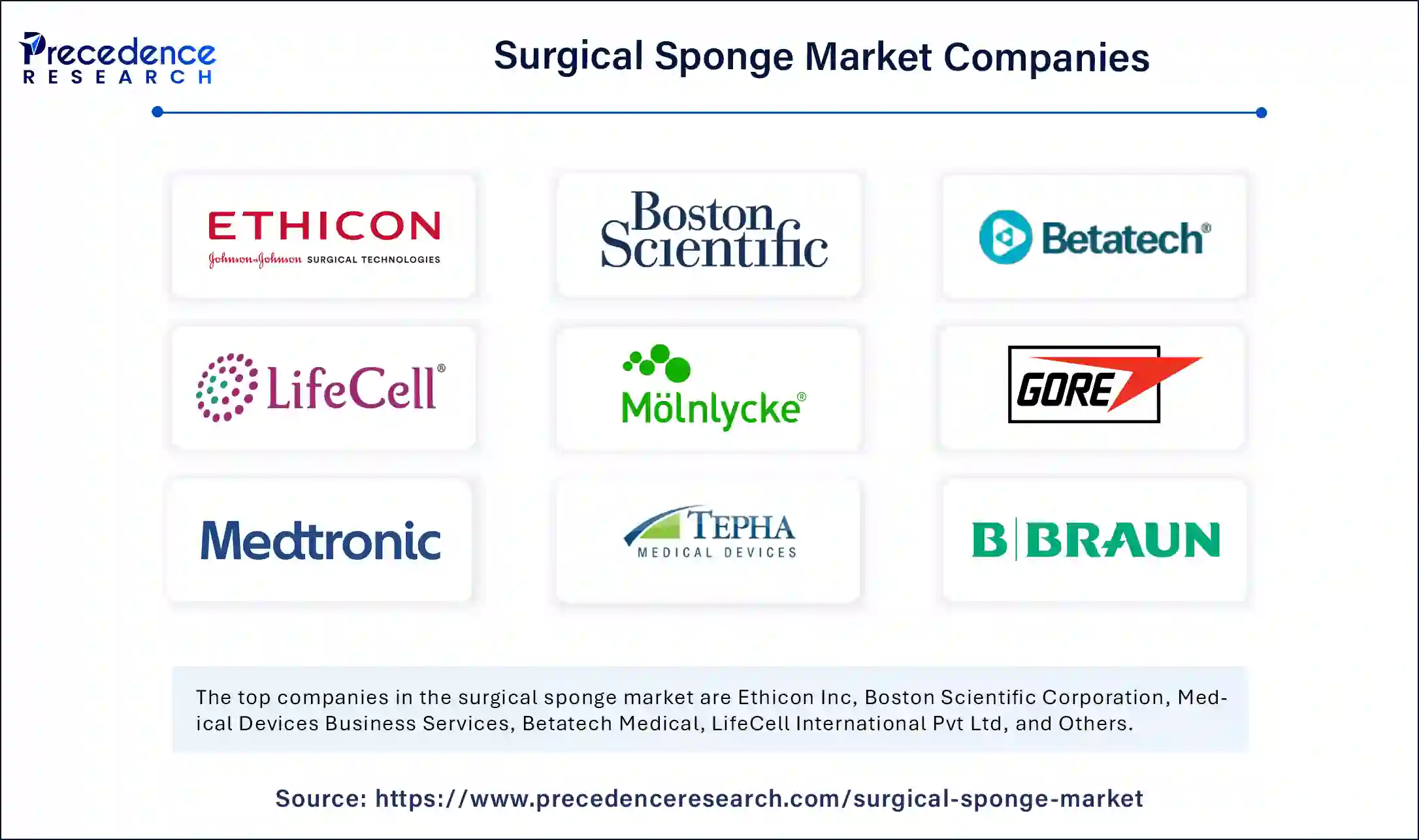September 2024
The global surgical sponge market size is calculated at USD 2.64 billion in 2025 and is forecasted to reach around USD 4.41 billion by 2034, accelerating at a CAGR of 5.84% from 2025 to 2034. The market sizing and forecasts are revenue-based (USD Million/Billion), with 2024 as the base year.
The global surgical sponge market size accounted for USD 2.50 billion in 2024 and is predicted to increase from USD 2.64 billion in 2025 to approximately USD 4.41 billion by 2034, expanding at a CAGR of 5.84% from 2025 to 2034. This growth is due to the increasing number of surgeries and advancements in healthcare infrastructure.

Artificial Intelligence is revolutionizing the market for surgical sponges by enhancing infection control, safety, and accuracy. Automating sponge tracking with smart RFID and computer vision technologies reduces human error and prevents retained surgical items. By identifying contamination risks during sterilization, machine learning improves quality control and guarantees higher safety standards. To improve patient care and lower complications, hospitals can also use predictive analytics to evaluate infection trends, streamline surgical procedures, and adhere to legal requirements.
Artificial intelligence is transforming not just surgery but also supply chains and product development. Systems for intelligent inventory management ensure effective resource allocation by preventing shortages and excess stock. The development of biodegradable antimicrobial and highly absorbent sponges suited for sophisticated processes is made possible by AI-driven material research. Artificial intelligence-assisted training programs and augmented reality (AR) simulations are improving sponge handling, streamlining surgical education, and lowering risks. AI is propelling major developments in this market with its capacity to maximize expense effectiveness and patient safety.
The surgical sponge market is expanding because of improvements in wound care, increased healthcare spending, and more surgeries. Sponge materials like cotton and non-woven fabric are preferred by hospitals and clinics because they are sterile, absorbent, and reasonably priced. Asia-Pacific is growing quickly while North America is at the top. Concerns regarding retained items and surgical site infections are addressed by innovations such as RFID and X-ray detectable sponges.
| Category | Key Focus Area | Future Potential for the Product |
| Better Products | Improve absorbency and add antibacterial features | Make safer sponges that help prevent infections |
| Eco-Friendly Products | Use biodegradable and reusable materials | Reduce waste and meet health regulations |
| Smart Technology | Add RFID/ barcodes for tracking | Prevent sponge misplacements during surgeries |
| Lower Costs | Use affordable material and better manufacturing | Make surgical sponges cheaper and more available |
| Report Coverage | Details |
| Market Size by 2034 | USD 4.41 Billion |
| Market Size in 2025 | USD 2.64 Billion |
| Market Size in 2024 | USD 2.50 Billion |
| Market Growth Rate from 2025 to 2034 | CAGR of 5.84% |
| Dominated Region | North America |
| Fastest Growing Market | Middle East and Africa |
| Base Year | 2024 |
| Forecast Period | 2025 to 2034 |
| Segments Covered | Type, End User, and Regions |
| Regions Covered | North America, Europe, Asia-Pacific, Latin America, and Middle East & Africa |
Advancements in wound care
Surgical sponges with RFID capabilities and X-ray detection are examples of technological innovations that help prevent retained surgical items (RSIs), a significant issue in operating rooms. These developments improve adherence to hospital safety procedures, surgical efficiency, and patient safety. High-absorbed sponges are also being developed for the market to promote healing and lower infection rates.
Risk of Surgical Site Infections
Surgical site infections (SSIs) are significant post-operative complications that increase patient mortality rates, prolong hospital stays, and raise healthcare costs. Poor or contaminated surgical sponges can worsen patient outcomes by introducing bacteria into wounds. Hospitals are increasingly using sterile, antimicrobial, single-use surgical sponges as regulatory bodies like the FDA, WHO, and CDC enforce stringent infection control guidelines, encouraging healthcare providers to use high-quality sponges. The rise in hospital-acquired infections has driven demand for advanced wound care products, including antibacterial and silver-coated sponges, which inhibit microorganism growth. Additionally popular is the use of eco-friendly, biodegradable, and disposable sponges, which lowers the risk of infection while also following sustainability trends.
Environmental concerns and disposal issues
Most surgical sponges are single-use and non-biodegradable, which significantly increases medical waste. Wasteful sponge disposal can result in environmental contamination, biohazard contamination biohazard contamination and higher waste management expenses for medical facilities. Although environmentally friendly biodegradable sponges are being created, their uptake is sluggish because of their limited supply and increased manufacturing costs. Furthermore, hospitals and manufacturers are being forced to look for more environmentally friendly production and waste management methods due to lightening regulations on medical waste disposal and sustainability initiatives.
Eco-friendly and biodegradable sponges
Biodegradable surgical sponges are becoming more popular due to the increased global focus on sustainability and the reduction of medical waste. Hospital and regulatory agencies are putting more emphasis on environmentally friendly medical supplies in an effort to counteract the negative environmental effects of single-use surgical instruments. Manufacturers can stand out in the market by creating sponges that are recyclable, composable, or biodegradable using organic and plant-based materials. Green medical product development is further aided by government initiatives that support sustainability in healthcare.
Increasing adoption of minimally invasive surgeries
There is a growing need for specialized high-absorbency non-linting surgical sponges due to the growth of laparoscopic robotic-assisted and micro-invasive procedures. To guarantee a clear surgical field and little tissue damage, these procedures call for precise, small, and extremely effective sponges. The demand for specially made surgical sponges for specialized medical producers of next-generation surgical supplies this change presents changes for product innovation.
The cotton gauze sponges segment held the largest surgical sponge market share in 2024, owing to their extensive use in surgical procedures for wound management, cleaning, and absorption. They are widely used in healthcare facilities due to their low-cost great availability and ability to prevent surgical site ability to prevent surgical site infection. In many medical applications, they are also a preferred option due to their compatibility with sterilization procedures. The market position of this segment has been further reinforced by the rise in surgical procedures performed globally and the aging population's increased need for frequent medical care. Additionally, there is a greater need for sterile cotton gauze sponges as a result of hospitals' increased emphasis on infection prevention and hygiene. Maintaining hospitals' market dominance has also been greatly aided by their established supply chains and large purchases.
The nonwoven sponges segment is anticipated to grow at the fastest CAGR over the projected period due to its superior absorbency, softness, and lower risk of lint formation compared to traditional cotton gauze sponges. One of the main reasons for the nonwoven sponges' quick market expansion is their improved patient safety features and growing use in minimally invasive procedures. Nonwoven sponges reduce the chance of wound contamination because they retain more fluid and shed less fiber than cotton gauze. The production of high-quality and reasonably priced nonwoven sponges has been made possible by technological developments in manufacturing processes, which has increased demand for them. Additionally, the use of disposable medical products in healthcare settings has increased the demand for them. Additionally, the use of disposable medical products in healthcare settings has increased because of infection control measures that have led to a growing preference for them. It is anticipated that nonwoven sponges will be widely used in ambulatory surgical centers and clinics as outpatient surgeries continue to grow.
The hospital segment dominated the global surgical sponge market in 2024 due to hospitals performing a significant volume of surgical procedures and requiring a high quantity of surgical wound care and infection control. The market dominance of hospitals has been reinforced by the existence of a well-established healthcare infrastructure, the availability of qualified medical personnel, and the rise in patient admissions for surgical procedures. The demand for surgical sponges is also fueled by the main locations for complicated and urgent surgeries. Governments and private healthcare organizations are making significant investments in hospital expansions and surgical equipment upgrades, which is helping to maintain demand. Furthermore, hospitals' rigorous adherence to infection control measures and hygiene standards guarantees ongoing purchases of sterile surgical sponges. This segment's growth is further aided by the increasing prevalence of chronic conditions like cancer and cardiovascular diseases that call for surgery.
The clinic segment is projected to grow rapidly in the coming years, driven by the increasing shift toward outpatient care and minor surgical procedures. There is a growing need for surgical sponges as clinics are better prepared to manage wounds, perform minor surgeries, and treat dermatological conditions. Patients are choosing clinics over hospitals because they are more convenient, more affordable, and have shorter wait times. The demand for premium surgical sponges has also increased due to the growth of specialty medical clinics, including orthopedic dental and cosmetic surgery facilities. The increasing emphasis on early-stage treatment and preventive healthcare at clinics is also anticipated to fuel explosive growth in the surgical sponge market. More clinics are opening as emerging economies' healthcare infrastructure advances, which is driving the growth of this market.
North America dominated the surgical sponge market in 2024, driven by its well-established healthcare infrastructure and high adoption of advanced medical technologies. Major medical device manufacturers are present, and strict laws guaranteeing high-quality surgical products have helped the region dominate the market because of the rising number of surgeries carried out each year and the rapidly aging population that necessitates frequent medical interventions. The United States plays a significant role in this dominance. Market expansion is also supported by robust reimbursement regulations, wide hospital networks, and continuous research into surgical innovations. North America continues to be the major player in the surgical sponge market thanks to ongoing improvement and infection prevention techniques.
Middle East and Africa is expected to grow at the fastest CAGR in the surgical sponge market over the period studied due to the rapid development of healthcare facilities, rising medical tourism, and increasing government initiatives to improve medical infrastructure. Surgical sponges are in greater demand in hospitals and ambulatory surgical centers as a result of the move toward modern medical practices and increased healthcare investments. Further propelling market expansion are the rise in private healthcare providers and the growing number of minimally invasive surgeries. The region is set to play a significant role in the global surgical sponge market as healthcare accessibility increases throughout emerging economies.
Europe holds a significant position in the surgical sponge market, supported by a strong focus on healthcare quality, regulatory compliance, and advancements in surgical procedures. The regions' need for surgical sponges has been fueled by the rising incidence of chronic illnesses that necessitate surgery, as well as government initiatives to improve patient safety regulations. Additionally, advancements in environmentally friendly surgical sponges have resulted from Europe's focus on biodegradable and sustainable medical products, with an aging population that needs frequent medical attention and ongoing advancements in healthcare services. Europe continues to be a vital market for producers of surgical sponges.

By Type
By End User
By Region
For inquiries regarding discounts, bulk purchases, or customization requests, please contact us at sales@precedenceresearch.com
No cookie-cutter, only authentic analysis – take the 1st step to become a Precedence Research client
September 2024
September 2024
January 2025
January 2025